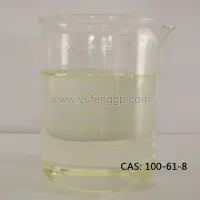Understanding N-Methylaniline: Properties, Uses, and Safe Handling
1. N-Methylaniline Properties
N-Methylaniline (C₇H₉N), also known as NMA or N-Methylbenzenamine, is an organic compound belonging to the aromatic amine family. It appears as a colorless to pale yellow oily liquid with a distinct amine-like odor. Over time, it may darken due to oxidation upon air exposure.
Key Physical and Chemical Properties:
Chemical Formula: C₆H₅NHCH₃
Molecular Weight: 107.15 g/mol
Boiling Point: ~194°C (381°F)
Melting Point: -57°C
Density: ~0.99 g/cm³ (at 25°C)
Solubility: Slightly soluble in water, but highly soluble in organic solvents like alcohol, ether, and benzene
Flash Point: Approximately 85°C
Appearance: Clear to pale yellow liquid
N-Methylaniline’s structure, featuring both aromatic and secondary amine groups, gives it strong reactivity as an intermediate in chemical synthesis.
2. What Is N-Methylaniline Used For?
N-Methylaniline serves as an important industrial intermediate in several manufacturing processes. Its primary applications include:
a. Fuel Additives
One of the major uses of N-Methylaniline is as an anti-knock agent in gasoline. It helps increase octane rating, improving engine performance and reducing knocking in combustion engines.
b. Dye and Pigment Production
It acts as a precursor in the synthesis of azo dyes and other colorants. The amine group enables reactions with diazonium salts to produce vivid, stable dyes used in textiles, inks, and coatings.
c. Rubber and Plastic Additives
In polymer industries, N-Methylaniline can be used in the production of antioxidants and stabilizers, enhancing material durability and resistance to degradation.
d. Pharmaceutical and Agrochemical Intermediates
It serves as a building block in organic synthesis, particularly for producing fine chemicals, pharmaceuticals, and pesticides.
e. Laboratory Research
In laboratories, N-Methylaniline is often used as a reagent or solvent in organic synthesis studies.
3. Difference Between N-Methylaniline and Aniline
While both compounds are aromatic amines derived from benzene, they differ structurally and functionally:
See also:Nitrous Oxide Specialty Gas vs. Other Specialty Gases: Which Is Better?
| Property | Aniline (C₆H₅NH₂) | N-Methylaniline (C₆H₅NHCH₃) |
|---|---|---|
| Structure | Primary amine | Secondary amine |
| Substitution | One hydrogen attached to nitrogen | One methyl group replaces a hydrogen |
| Boiling Point | ~184°C | ~194°C |
| Solubility | More soluble in water | Less soluble in water |
| Reactivity | Higher reactivity toward electrophilic substitution | Slightly less reactive due to methyl substitution |
| Applications | Dyes, pharmaceuticals, polyurethane precursors | Fuel additive, dye intermediate, stabilizers |
Are Specialty Gases in SF4 Safe for Your Industrial Applications?
In summary, N-Methylaniline has a methyl-substituted nitrogen atom, making it less polar and slightly less reactive than aniline but more stable and useful in specialized chemical formulations.
4. How to Handle N-Methylaniline Safely
N-Methylaniline should be treated with caution due to its toxic and potentially harmful properties. Proper storage, handling, and disposal are essential in industrial and laboratory environments.
a. Health Hazards
Toxic if inhaled, ingested, or absorbed through the skin
Can cause methemoglobinemia (a blood disorder reducing oxygen transport)
May irritate eyes, skin, and respiratory tract
Prolonged exposure may damage liver, kidneys, or blood cells
b. Safety Precautions
Always work in a well-ventilated area or fume hood
Wear personal protective equipment (PPE): gloves, goggles, lab coat, and chemical-resistant apron
Avoid direct contact and inhalation of vapors
Store in tightly sealed containers, away from heat, oxidizers, and light
Handle under dry, cool, and inert conditions to prevent degradation or oxidation
c. Spill and Disposal Guidelines
In case of spills: absorb with inert material (sand or vermiculite) and dispose according to local environmental regulations
Waste should be treated as hazardous chemical waste
Follow regional disposal regulations (e.g., EPA, REACH, or local environmental laws)
Conclusion
N-Methylaniline CAS 100-61-8 is a versatile chemical with valuable industrial applications, particularly in fuel additives, dye synthesis, and organic intermediates. Understanding its properties, differences from aniline, and safe handling practices is crucial for professionals in chemical manufacturing and research.
If your business sources or uses aromatic amines, ensure compliance with safety standards and environmental regulations to maintain responsible and sustainable chemical operations.



